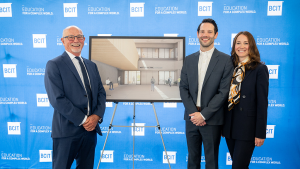Founded 25 years ago, the environmental engineering program (EE) at British Columbia Institute of Technology (BCIT) has stayed up to date by adapting its curriculum to society’s changing understanding of the environment and humanity’s place in it.
Today’s program covers a wide range of topics: Sustainability management, air quality, climate change, environmental impact assessment, life cycle assessment, contaminated sites, water treatment facilities, contaminant hydrogeology, integrated solid waste management, resource management and green energy technology.
That’s a lot, but when the program was founded in 1996, its scope was more modest.
“Unlike in the past, today we acknowledge the environment refers to anything that surrounds us, including our natural world – forests, rivers and wildlife – as well as such man-made constructions as buildings, roads and bridges,” said Dr. Olga Petrov, head of BCIT’s EE program. “Our lives depend on the environment for resources and life support, but, at the same time, our activities have a great impact on that environment.”
Petrov says it’s only quite recently that society has realized it can’t continue to exploit everything endlessly.
“The environment reacts to human activity and we must take its responses into account,” said Petrov. “We need to live within the Earth’s capacity.”
BCIT EE adds new scientific knowledge to its program as it is developed.
“The first change to our original program was in 2009, when a systems approach was introduced,” said Petrov. “It’s more holistic, because it considers humans as part of ecosystems. It’s not ‘people are on one side and the environment is on the other, and we’re entitled to do whatever we want with it’.”
The next change to the program took place two years ago, in 2019.
“Now we emphasize not just technical knowledge, but also creativity and recent innovations, such as district energy subsystems and new sources of energy, like biomass, geothermal and small-scale hydro,” said Petrov.
The EE program focuses on the study of ecosystems, which are made up of living organisms (such as humans) interacting in the non-living environment (soil, water, air).
The Earth’s ecosystems provide humanity with a variety of beneficial services: Support (nutrients, soil formation), supplies (food, clean water, fuel), feedback (climate change), and culture (spiritual, educational).
“As a result, we humans have to be more careful with our actions,” said Petrov.
Ecosystems are dynamic systems, she says.
“A systems approach is needed to understand the dynamic feedback loops between all of the elements of that ecosystem,” said Petrov.
According to BCIT EE’s systems approach, every aspect of a building, infrastructure or energy project needs to be taken into account.
“We now assess activities and products in terms of the energy and materials that are used, as well as waste produced, over the entire life-cycle of that product or activity in everything from resources extraction to manufacturing and transportation,” said Petrov.
The BCIT EE program has some unique features, she says.
“Unlike many other environmental programs, our courses teach about all the environmental spheres – air, water, groundwater, soils and energy – all with sustainability principles embedded in them,” she said. “In addition, we insist our students have hands-on skills, so that our graduates are job-ready from the start. Our faculty are not only academically strong… but they are coming from industry as long-time practitioners and professionals.”
Some novel and interesting research work has been coming out of BCIT EE.
Petrov, who did her PhD dissertation on measuring the impact of biomass-based district heating systems on air quality, was adviser on Johnny Le’s 2019 project on the odour and air quality impact of cannabis production and cultivation facilities in Metro Vancouver and the Fraser Valley.
“Following the legalization of cannabis and the development of farms to grow it, it’s an important general practice to evaluate its impact on the environment,”said Petrov. “We are conducting the assessments in order to quantify the impact of cannabis farms on air quality and to develop appropriate policies for environmental protection.”
Petrov was also the primary adviser for Dana May’s 2021 project called “Investigation of vertical temperature profiles in downtown Vancouver,” on the urban heat island effect in densely populated urban areas and its implications for eco-city planning.
“An urban heat island is a phenomenon of increased atmospheric temperatures over cities compared to rural areas,” said Petrov. “It is caused by the densification of such as things as housing, heating sources, transportation, building materials and paved surfaces.”
Increased temperatures are one of the important precursors to the formation of ground-level ozone and air pollution in general.
“This investigation is useful because the results should help city planners design housing materials and green spaces so as to minimize the negative impacts of urbanization,” said Petrov.










Recent Comments